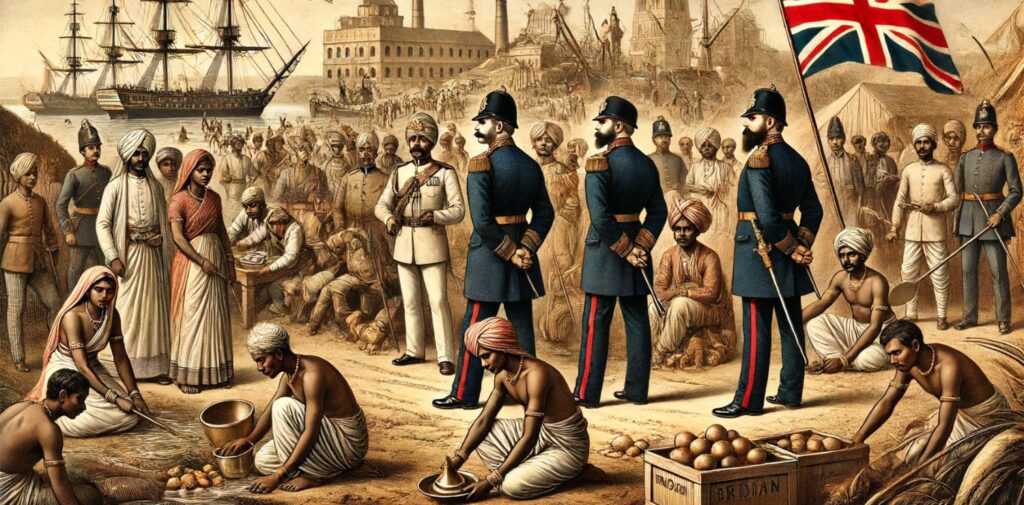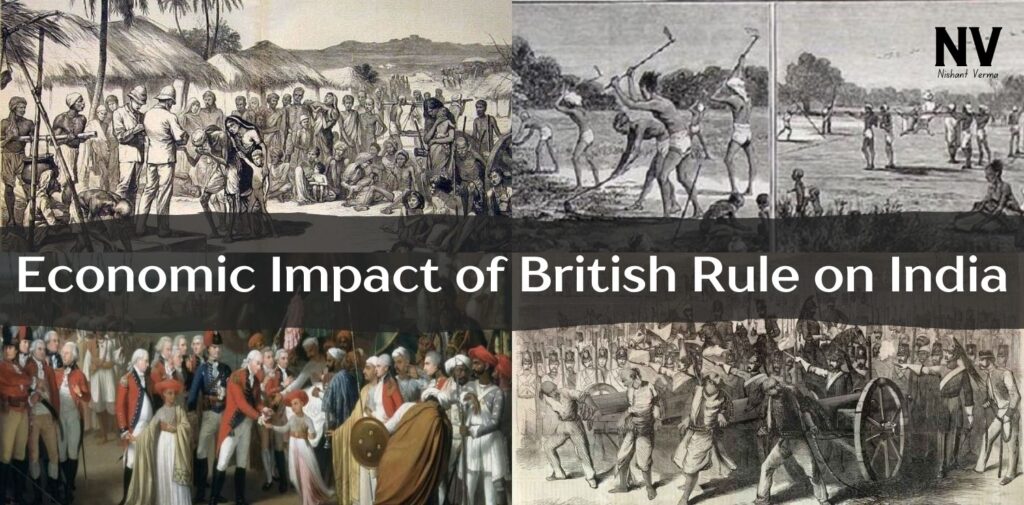When the British East India Company arrived in India in the early 1600s, it marked the beginning of British colonial rule in the country. Over the next two centuries, British control over India transformed its economy in profound ways. While India was rich in resources, skilled labor, and agricultural production, the British used the country primarily for their own economic benefit, extracting wealth and altering the structure of India’s economy. This article explores the long-lasting Economic Impact of British Rule on India, focusing on how it affected agriculture, industry, trade, and the overall well-being of the Indian population.
Transformation of India’s Agriculture
One of the most significant changes brought about by British rule was in India’s agricultural sector. Before British colonization, India had a thriving agricultural system that was highly self-sufficient. Indian farmers grew a variety of crops, and the country’s economy was largely based on agriculture. However, during British rule, the British government altered this structure to suit their economic interests.
Under British rule, much of India’s agricultural land was repurposed to grow cash crops like cotton, indigo, and opium, which were in high demand in Britain and other parts of the world. This shift from food crops to cash crops made India dependent on foreign markets, reducing the production of essential food grains needed for the population. As a result, India experienced periodic famines, and millions of people suffered due to the shortage of food.
The British also introduced exploitative land revenue systems, such as the Permanent Settlement in Bengal, which burdened Indian farmers with high taxes. These taxes were fixed, even during times of drought or crop failure, making it impossible for farmers to survive. This led to widespread poverty among Indian farmers and contributed to the collapse of local agriculture.

Decline of Indian Industries
Before the arrival of the British, India was a major center of trade and industry. Indian textiles, including fine cotton and silk fabrics, were highly sought after in international markets. Indian handicrafts and metalwork were also well-regarded. However, British colonial policies severely damaged India’s traditional industries.
The British imposed heavy tariffs and duties on Indian goods, particularly on textiles. At the same time, they flooded India with cheap British-made goods, including textiles, which were often of inferior quality. This severely damaged local industries, leading to the decline of Indian handicrafts and textiles. Indian weavers, for example, were unable to compete with the mass-produced British textiles and lost their livelihoods.
Additionally, the British established a system where raw materials like cotton, jute, and indigo were exported to Britain for manufacturing. Finished goods were then sent back to India, often at higher prices. This not only stunted the growth of local industries but also made India a market for British manufactured products, rather than a producer of goods. Over time, India’s industrial base was weakened, and the country became more reliant on British goods, hindering its economic development.
Destruction of Local Trade Networks
Before British colonization, India had a vast network of trade routes that connected various regions of the country, as well as international markets. Indian merchants and traders conducted thriving trade both within the country and abroad. However, British colonial rule disrupted this trade system.
The British imposed monopolies on trade and controlled key ports and resources, like salt and saltpeter, which were vital to India’s economy. They also built infrastructure like railways and roads, but these were primarily designed to extract resources from the interior of the country and transport them to British ports for export. The railway system, which could have been used to connect Indian markets, was instead built to serve British interests. The focus was on transporting raw materials to ports, rather than fostering internal trade or connecting local markets.
Furthermore, British policies disrupted the traditional economic activities of local traders. For instance, the British pushed for a system of fixed prices and taxes, which left local businesses with little control over their markets. Many small-scale traders and artisans were forced out of business, and the once-thriving local trade networks collapsed.

Exploitation of Indian Resources
India is rich in natural resources such as minerals, forests, and agricultural land, but during British rule, these resources were systematically exploited to benefit Britain. The British extracted resources like coal, iron ore, and timber from India and used them to fuel their own industrial growth. These resources were often extracted at low costs, and India saw little benefit from the wealth generated.
Additionally, the British exploited India’s rich agricultural land to grow crops that were in demand in European markets, such as cotton and tea. However, these crops were not for the benefit of the local population but were exported to meet the needs of the British economy. This drained India’s resources and left its agricultural sector struggling to provide enough food for its own people.
Economic Drain and Wealth Extraction
One of the most significant economic impacts of British rule in India was the concept of the economic drain. The British extracted immense wealth from India, which led to the impoverishment of the country. The wealth generated from India’s natural resources, industries, and agriculture was sent back to Britain, leaving India with little in return.
The drain of wealth occurred in several ways. First, British merchants and companies made profits from the raw materials and agricultural products exported from India. Second, the British government imposed heavy taxes on Indian farmers, which were used to fund British administrative expenses and military operations. Lastly, British officials and settlers in India sent their salaries and earnings back to Britain, further depleting India’s wealth.
The economic drain left India impoverished, with a large portion of its population living in poverty. India’s infrastructure, education, and healthcare systems were also neglected, and the British took little responsibility for improving the lives of ordinary Indians.

The Impact on Indian Society
The economic changes brought about by British rule had a far-reaching impact on Indian society. The destruction of traditional industries, the exploitation of agricultural land, and the drain of wealth contributed to widespread poverty and social unrest. India’s economy became heavily dependent on Britain, and the local population was left with few opportunities for growth and development.
India also experienced a rise in unemployment as local industries collapsed and foreign goods flooded the market. The working class, particularly in rural areas, suffered from poverty, malnutrition, and poor living conditions. The middle class, which had traditionally been a stabilizing force in Indian society, was weakened by the economic policies of the British.
Additionally, the colonial economy reinforced social inequalities. The British focused on maintaining the existing caste and class systems, which further marginalized certain sections of society, particularly the lower castes and indigenous populations. The wealth generated from India’s resources mostly benefited the British colonial rulers and a small elite class, leaving the majority of the population in abject poverty.
The Aftermath of British Rule
When India gained independence in 1947, it faced enormous economic challenges. The country’s industrial base was weak, agriculture was underdeveloped, and the economy was heavily dependent on foreign trade. The legacy of British colonial rule had left India with an economy that was structured to serve the needs of Britain, rather than its own population.
After independence, Indian leaders focused on rebuilding the country’s economy and reducing its dependence on foreign powers. They implemented a series of economic reforms, including land redistribution, industrialization, and the development of a self-sufficient agricultural system. Despite these efforts, the long-lasting impact of British colonial economic policies could not be undone overnight.
Conclusion: Impact of British Rule on India
The economic impact of British rule on India was overwhelmingly negative. The British systematically exploited India’s resources, damaged its industries, and imposed policies that impoverished its population. The legacy of British colonialism left India with a weak economy, widespread poverty, and a lack of industrial development. While India has made significant progress since gaining independence, the scars of colonial economic policies are still visible today.
Understanding the economic impact of British rule on India is crucial, not only for appreciating the challenges the country faced in rebuilding after independence but also for recognizing the resilience of the Indian people in overcoming these obstacles. The struggle for independence was, in many ways, a struggle for economic freedom, and the efforts of those who fought for a free India laid the foundation for the country’s future growth and development.




